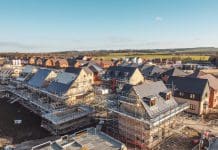England’s green belt could facilitate the construction of over 73.7m new build plots, according to research from Woods Hardwick
England’s green belt covers 12.5% of the nation’s total land area. Only 1.4% of this land is needed to deliver the government’s target of 1m homes by the next election.
The UK introduced the green belt in the 1950s to curb urban expansion. A common misconception is that the green belt is protected as a scenic or ecological area similar to natural beauty spots.
Only 8.7% of England’s green land is developed, with 10.5% ‘built-up’, highlighting the green belt’s potential to ease the housing crisis.
England’s green belt could solve the housing crisis
According to Woods Hardwick, the land could accommodate 73.743m new homes. This disputes the 2021 ONS figure of 24.8m.
London’s 34,772-hectare green belt (22.1% of the region’s land) could house 1.566m homes. The West Midlands (over 20% green belt) could offer 11.925m homes, while the South East’s 16% green belt could yield 13.751 new homes.
In each case, a slight release of green belt land could greatly aid housing needs.
Northumberland, with just a 14% green belt, could accommodate 3.166m homes. Certain localities like Tandridge, Epping Forest, Sevenoaks, and others have large areas of green belt with significant housing potential.
“Sensibly planning the release of green belt land will directly address the housing crisis and local property shortages,” said Russell Gray, planning director at Woods Hardwick.
“That doesn’t mean concreting over the entire countryside as many incorrectly assume, and there are swathes of green belts that have been incorrectly classified and contribute little to the intended purposes of green belts in national policy,” he added.
The case against brownfield land
On the whole, policymakers accept the need for planning system reform. Many have supported the development of brownfield land over the development of green belt.
Brownfield is defined as land that has been developed for industrial purposes that has been polluted or abandoned.
According to research from Lichfield’s, even if every available brownfield site was used for housing, it would still fail to meet the government’s 300,000 homes a year target in the long term – only a third of what is needed over the next 15 years.
“England’s entire green belt could deliver almost 24m new homes – three times as many homes we already have – and it would take reclassifying just 1.4% of green belt land for the government to meet its target of one million homes by the next general election,” commented Gray.
“Instead, they’ve set their sights on brownfield redevelopment, a task that is far more complicated, costly and, quite frankly, doomed to fail due to there simply not being enough of such land. It also typically fails to provide the level of affordable housing we desperately need as a country,” he concluded.














